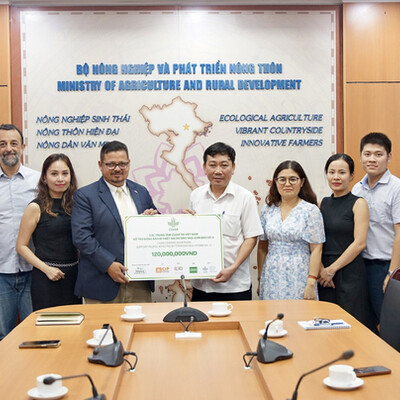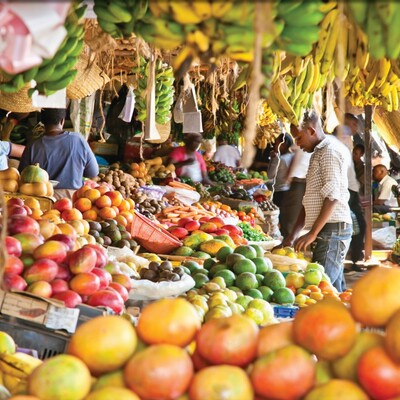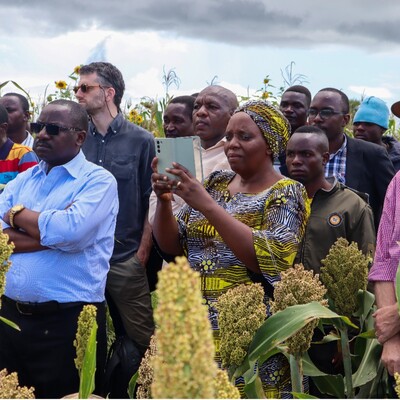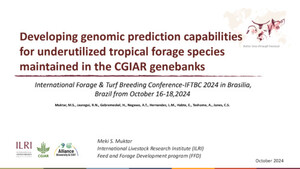

A smart—and smartly delivered—advisory service for Rwanda's small-scale farmers
A cost-effective fertilizer recommendation tool developed for six staple crops in Rwanda has been successfully plugged into the country's innovative Smart Nkunganire System, popularly known as 'SNS', which gives Rwandan farmers access to critical subsidized farm inputs. The new tool, which is maintained by the Rwanda Agriculture and Animal Resources Development Board (RAB), recommends fertilizers tailored to farmers’ specific locations and needs. This tool is enhancing efficient fertilizer use, crop yields and sustainable farming practices. Its success should provide proof-of-concept to pave the way forward for incorporating other types of agronomic advisories in the SNS platform.
The problem: Small farms, small rewards
Most rural households in Rwanda (85%) cultivate crops on less than one hectare and some half of the households farm less than one-third of a hectare. The soils in this country's tiny farm plots are generally poor in nutrients, eroding their productive capacity. But fertilizer use here as elsewhere in Africa remains low, resulting in yields far below their potential.
The solution: Digitalized agricultural extension services
To address these issues, the Government of Rwanda launched a Crop Intensification Programme in 2007 to increase the productivity of the country's major crops by consolidating land-use, improving the distribution of seed and fertilizer, and expanding agricultural extension services. This program led to notable increases in the production levels of high-priority crops. At the same time, the government promoted the digitalization of Rwanda's agricultural extension services.
A critical component of the Crop Intensification Programme is a fertilizer scheme that facilitates farmers' access to inorganic fertilizers at subsidized prices. This scheme has relied on blanket fertilizer recommendations that are applied uniformly across the country, despite Rwanda's highly heterogeneous agro-ecological conditions. This one-size-fits-all approach results in inefficient use of expensive inputs, suboptimal fertilizer responses, and low-profit margins for farmers. Experiences from other countries suggest that site-specific fertilizer advisory services could increase farm yields by at least 20% while also reducing environmental risks.
Between 2018 and 2021, CGIAR scientists worked with RAB to pilot delivery of site-specific fertilizer recommendations for potato and cassava in selected agro-ecological zones. This involved gathering data on fertilizer response variations through multi-location trials using a Smart Agronomy Data Management (SAnDMan) digital tool. Building on this work, RAB launched the Rwanda Soil Information System (RwaSIS) project, funded by the Bill & Melinda Gates Foundation, to develop a comprehensive digital soil information system. This initiative involved extensive fertilizer response trials for six priority crops (cassava, potato, rice, wheat, maize, and beans) over multiple cropping seasons, with data from these trials forming the basis for improved fertilizer recommendations.
Crop models and machine learning algorithms were calibrated to generate recommendations based on digital soil information and farmer-supplied input variables using AgWise tools and algorithms developed by CGIAR's Excellence in Agronomy Initiative. Innovative validation approaches were also developed for on-farm conditions. As a result of Rwanda's massive digitization drive, including the digitization of the agro-input supply chain and subsidy scheme through the SNS platform in 2018, developed by BK Techouse and RAB, Rwanda now has a robust platform with over 1.5 million registered users. With these advances, integration of advisory services such as the FRT into SNS is now seen as a key strategy for delivering cost-effective site-specific fertilizer recommendations to Rwanda's millions of small-scale farmers.
The objective of the project was to co-create a cost-effective way of providing Rwanda's farmers with site-specific fertilizer recommendations tailored to their specific locations and needs and plugged into Rwanda's Smart Nkunganire System (SNS).
Every farmer is now able to get her own fertilizer recommendation using a Unique Parcel Identifier for her land as registered by the Rwandan Government. This information is then tied to the national ID system.
How the fertilizer recommendation tool works
Farmers register themselves using their phones after which an agronomist approves their registrations, which enables the farmers to access subsidized inputs, including the fertilizer recommendation. The farmers order the recommended inputs, which are sent to particular agro-dealers selected by the farmers. One of several suppliers then goes through an Agro Processing Trust Cooperation (APTC), the government’s managing body, which pays the agro-dealers for the subsidized inputs.

Warehouse of a Rwandan agricultural input supplier (photo credit: CIP).
The Innovation Packaging and Scaling Readiness Workshop
In December 2023, CGIAR's Excellence in Agronomy Initiative, which developed the SNS fertilizer recommendation tool, was invited to apply for a competitive grant from the Ukama Ustawi Scaling Fund. Succeeding, the first thing we did was to take part in an Innovation Packaging and Scaling Readiness (IPSR) workshop, organized by the Scaling Fund, in April of this year, in Kigali, where 27 policymakers, extension officers, agro-dealers and SNS software developers participated, along with staff from RAB and BK Techouse.
This IPSR workshop was quite an eye-opener for us. We were able to determine both potential bottlenecks and potential 'enablers' to achieving our ambition. In particular, we looked at how to make the system more user-friendly, how to ensure that the system is affordable and sustainable, how to improve the input supply chain, and how to ensure timely subsidy payments and sustained private-sector involvement.
Staff of the International Potato Center (CIP), RAB and the CGIAR Excellence in Agronomy Initiative brought together stakeholders from research, private, and public institutions to explore the tool's readiness for broad adoption. The Ukama Ustawi Scaling Fund is managed by the CGIAR Initiative on Diversification in East and Southern Africa and the CGIAR Portfolio Performance Unit and coordinated by the Impact at Scale Program of the International Livestock Research Institute (ILRI).
Key challenges
During the workshop, participants identified the following challenges to the adoption of the SNS-FRT.
• Limited user awareness: Many farmers are registered with SNS but do not fully understand how it works or how to use its features.
• System complexity: The SNS system is complex, requiring up to 240 steps via USSD to request fertilizer.
• Technical hitches: Mobile network limitations and the need for the Mobile Order Processing Application (MOPA) to be online can cause accessibility problems, timeouts and delays in confirming sales.
• Financial sustainability: The financial sustainability of the SNS system is uncertain if the government withdraws its support. The high cost of fertilizer is also a barrier for farmers.
• Delays in fertilizer supply: The fertilizer supply chain can be slow, resulting in delays from the time of ordering to delivery, with the result that farmers receive their fertilizer late for the planting season.
• Limited functionality: The SNS-FRT does not currently integrate recommendations for organic fertilizer, lime, or micronutrients, limiting its usefulness for farmers.
Key solutions
To address these issues, participants proposed the following solutions.
• Simplify the SNS-FRT interface, reducing the number of steps for requesting fertilizer and making the application available offline to overcome connectivity issues.
• Launch an awareness campaign to educate farmers, extension agents, and agro-dealers about the SNS-FRT through demonstrations, training and media campaigns.
• Provide price stability and mitigate financial risk via partnerships with government, private-sector entities, and funders.
• Establish two-way communication channels between developers and end-users to enable farmers to provide feedback and suggest improvements.
• Promote responsible and effective fertilizer application by integrating compliance protocols into training and sensitization sessions.
• Connect agricultural extension agents and agro-dealers to facilitate access to SNS-FRT and support the agricultural value chain.
In October RAB invited us to work with them to develop a user manual outlining how to navigate the SNS—whether farmers using the USSD, sector agronomists using the web-based platform or agro-dealers using the MOPA app.
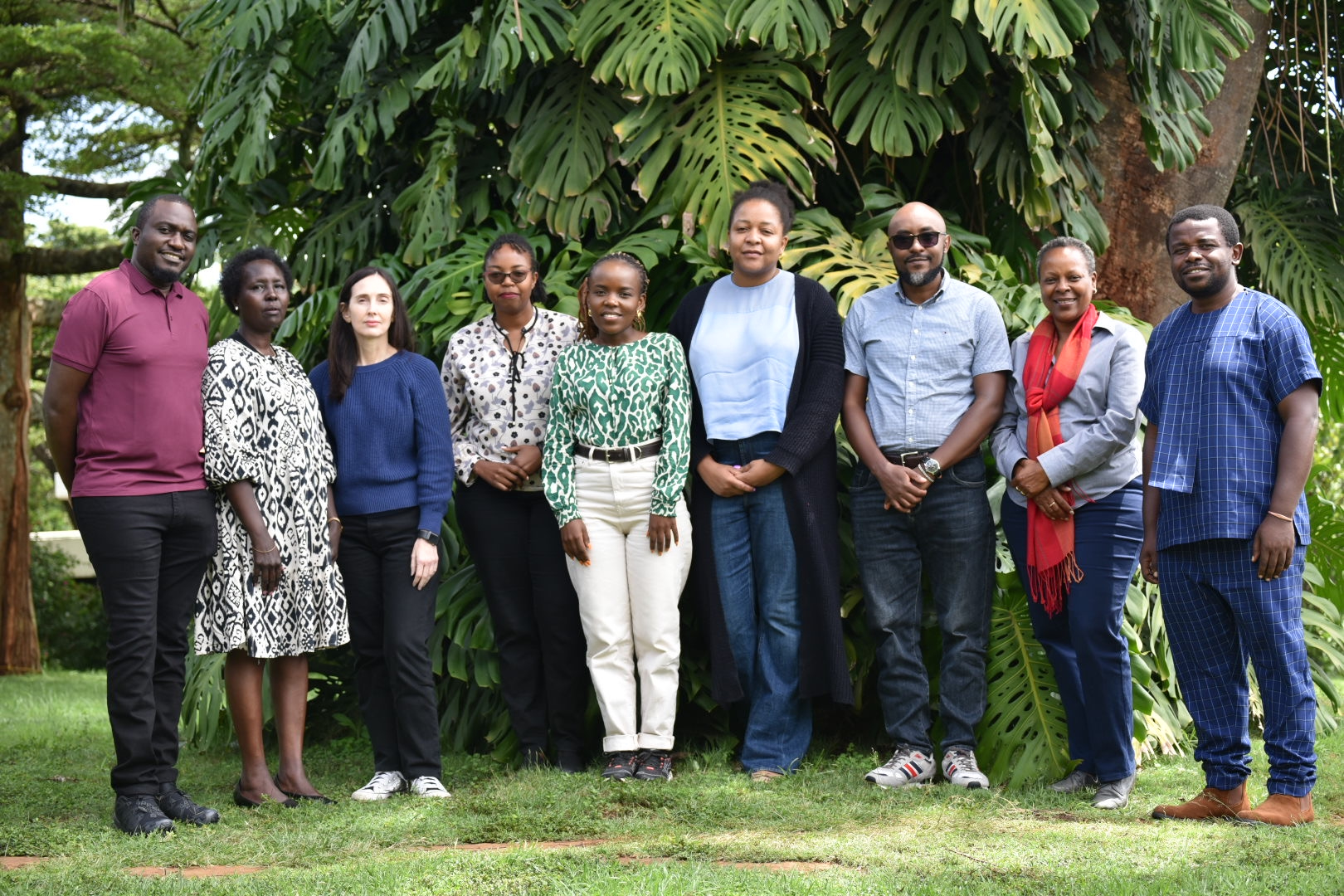
Participants at the 2-day writeshop held in Nairobi in November 2024, from left to right: Bester Mudereri (CIP), Dinah Borus (CIP), Tanya Rabourn (IITA), Esther Kihoro (ILRI), MaryFaith Simiyu (consultant), Elizabeth Kamau (IITA), Edwin Kang'ethe (CGIAR System Office), Wanjiku Guchu (IITA), and Moussa Senge (RAB and OAF), and with online participation by Murat Sartas (IITA, not pictured)) (photo credit: CIP).
Insights from a recent writeshop and surveys
Further insights were gathered during a writeshop held 18–19 November 2024 in Nairobi and through surveys conducted across Rwanda. Stakeholder mapping and interviews with farmers and agro-dealers identified three key opportunity areas.
• Trustworthy guidance: Many farmers perceive the SNS-FRT primarily as a means to access subsidies rather than as an advisory tool. Efforts are needed to emphasize the value of tailored fertilizer recommendations, including providing messages that explain how recommendations were determined and promoting the advisory aspect through radio spots.
• Independent use: Many farmers use agro-dealers and other intermediaries to access the SNS-FRT, which limits their ability to benefit directly from the advisory services. Digital literacy workshops and direct training could empower farmers to use the system independently.
• Scaling adoption: Simplifying the USSD interface and ensuring consistent access to the SNS-FRT throughout the year can help increase adoption rates. Addressing connectivity issues and developing alternative access methods, such as a WhatsApp chatbot, could also improve user experience.
The November writeshop emphasized enhancing user experience, simplifying procedures to reduce fraud, and building stakeholder capacity to effectively scale the tool.
Scaling ambition
A scaling plan, led by RAB in partnership with BK Techouse, One Acre Fund, and farmer cooperatives, rolled out SNS-FRT for two of the six priority crops initially, with a pilot involving 10,000 farmers. By 2025, the tool is expected to benefit at least 300,000 farmers, with the eventual goal of reaching over 1.5 million SNS-registered farmers.
With our pilot phase completed, we have a scaling ambition to have at least 20% (300,000) of the 1.5 million farmers registered with SNS using our agricultural advisory by 2025 or 2026.
Role of Ukama Ustawi Scaling Fund
The Ukama Ustawi Scaling Fund played a critical role in advancing the adoption of SNS-FRT by providing the financial support needed to conduct the IPSR Workshop, engage stakeholders, and evaluate the system's readiness for scaling. The Fund's support has enabled ongoing improvements in the tool's development, such as making the interface user-friendly and exploring sustainable business models for broader adoption.
In our recent writeshop, we worked to finalize a scaling strategy and develop an implementation plan. Our main jobs now are to continue to improve the tool's usability and to expand its reach, to diversify our funding sources, and to train many more women and young people to ensure equal access to these digital services.
A public-private partnership that works
Using a 'mobile-first' design has been a big strategic win in Rwanda, where mobile phone usage is widespread. The country's SNS is a prime example of a successful public-private partnership, with the Rwandan government, through MINAGRI, RAB and NAEB, setting the policy direction and providing the necessary funding and telecom companies and agro-input suppliers bringing technological expertise and distribution networks to the table. The impressive numbers—over 1.5 million SNS registered farmers and over 90% of the country's subsidized fertilizers distributed through the system—speak to the effectiveness of this PPP model.
Photo credits: All photos by the International Potato Center; the header image shows Rwandan farmers using the SNS fertilizer recommendation tool.
You may also like
Related Publications

Cultivated forages boost production and income for dairy farmers in Bishoftu District, Ethiopia
- Bezabih, Melkamu
- Adie, Aberra

Training of local stakeholders on animal nutrition in Son La Province, Vietnam
- Tran, Thi Bich Ngoc
- Tran, Viet Phuong
- Nguyen, Thien Truong Giang
- Do, Trong Hieu
- Nguyen, Tien Sinh
- Dao, Thi Thu Hang
- Atieno, Mary
- Peters, Michael
- Duncan, Alan J.

One Health scientific conference: International practices and lessons learned for Vietnam
- Vietnam One Health Partnership
- International Livestock Research Institute

Improving the livestock greenhouse gas inventory in Southeast Asia. Proceedings of a special session held during the International Conference on Sustainable Animal Agriculture for Developing Countries (SAADC) biennial conference
- Wilkes, A.
- Hegarty, R.
- Whitbread, Anthony M.
- Maeda, K.
- Hassim, H.A.
- Liang Juan Boo







